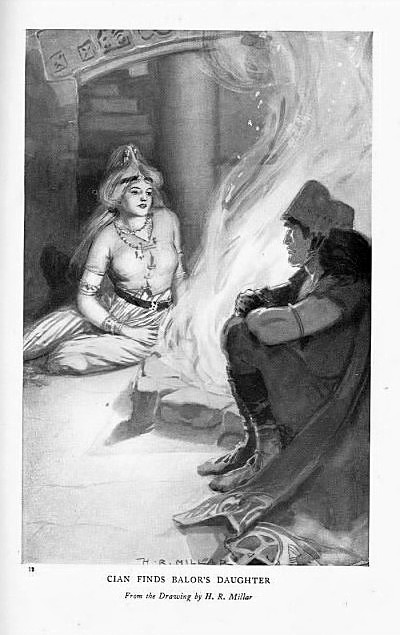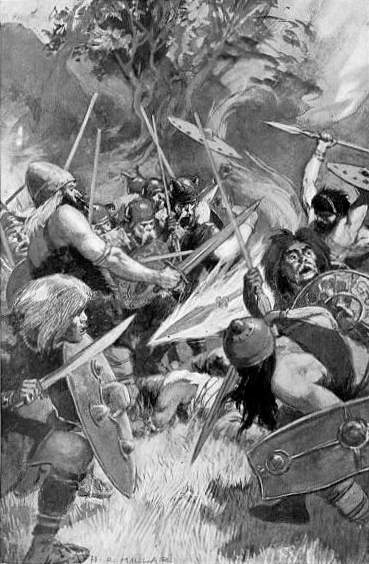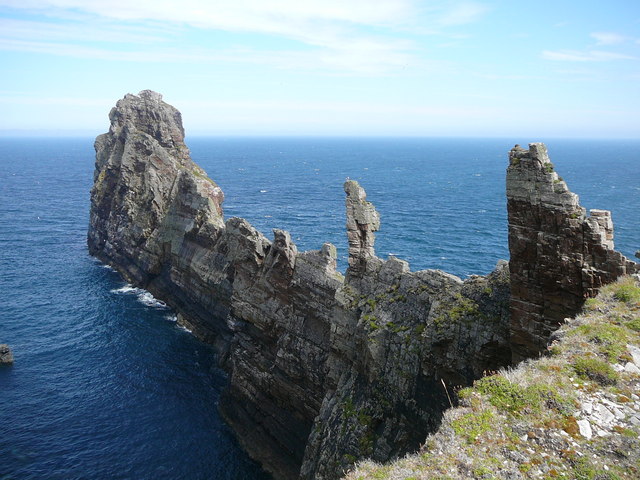|
Biróg
Biróg (Biroge of the Mountain, Birog), in Irish folklore is the ''leanan sídhe'' or the female familiar spirit of Cian who aids him in the folktale about his wooing of Balor's daughter Eithne. She is reinvented as a druidess in Lady Gregory and T. W. Rolleston's retellings. Attestations A version of the folktale recorded by John O'Donovan in 1835 relates how the Fomorian warrior Balor, to frustrate a prophecy that he would be killed by his own grandson, imprisons his only daughter Eithne in the tower of Tory Island, away from any contact with men. But Biroge of the Mountain helps a man called Mac Cinnfhaelaidh (Mac Kineely), whose magical cow (Glas Gaivlen ''recté'' Glas Gaibhnenn) Balor stole, to gain access to the tower and seduce her. Eithne gives birth to triplets, but Balor gathers them up in a sheet and sends a messenger to drown them in a whirlpool. The messenger drowns two of the babies, but unwittingly drops one in the harbour, where he is rescued by Biróg. S ... [...More Info...] [...Related Items...] OR: [Wikipedia] [Google] [Baidu] |
Cian
In Irish mythology, Cian or Cían (), nicknamed Scal Balb, was the son of Dian Cecht, the physician of the Tuatha Dé Danann, and best known as the father of Lugh Lamhfada. Cían's brothers were Cu, Cethen, and Miach. Cían was slain by the Sons of Tuireann, for which Lugh demanded various treasures around the world as éraic (compensation), according to the account in the "Book of Invasions" (''Lebor Gabála Érenn'', LGE) as well as the late romance version "The Fate of the Children of Tuireann". Name Cían means "enduring one"; ''cían'' signifying "long, enduring, far, distant". Scal BalbLebor Gabála Érenn, , p. 101 (Introduction); ¶311 p. 116 ¶330 p. 148–, ¶368 p. 186– is a nickname borne by other personages and means "dumb champion", with "dumb" in the sense of unable to make speech. By most accounts, Lug's mother is the Fomorian princess Ethniu,Lebor Gabála Érenn, ed. tr. ¶311 p. 117 but according to an interpolated text the LGE, Cían is also known by t ... [...More Info...] [...Related Items...] OR: [Wikipedia] [Google] [Baidu] |
Fomorians
The Fomorians or Fomori ( sga, Fomóire, Modern ga, Fomhóraigh / Fomóraigh) are a supernatural race in Irish mythology, who are often portrayed as hostile and monstrous beings. Originally they were said to come from under the sea or the earth. Later, they were portrayed as sea raiders and giants. They are enemies of Ireland's first settlers and opponents of the Tuatha Dé Danann, the other supernatural race in Irish mythology; although some members of the two races have offspring. The Tuath Dé defeat the Fomorians in the '' Battle of Mag Tuired''. This has been likened to other Indo-European myths of a war between gods, such as the Æsir and Vanir in Norse mythology and the Olympians and Titans in Greek mythology. One theory is that the Fomorians were supernatural beings representing the wild or destructive powers of nature; personifications of chaos, darkness, death, blight and drought.MacCulloch, John Arnott. ''The Religion of the Ancient Celts''. The Floating Press, 2 ... [...More Info...] [...Related Items...] OR: [Wikipedia] [Google] [Baidu] |
Ethniu
In Irish mythology, Ethniu (), or Eithne (Modern Irish pronunciation: ) in modern spelling, is the daughter of the Fomorian leader Balor, and the mother of Lugh. She is also referred to as Ethliu (modern Eithle), Eithlionn (genitive; modern Eithleann), and Ethlinn (dative; modern Eithlinn). Name Ethniu is a fine example of the difficulty of conducting research into Irish mythology. Her oldest version of her name is probably Ethliu or Ethniu, giving rise to the modern Irish name Eithne. However thanks to changes in the Irish language, the lack of standardised spelling for many centuries, and attempts to anglicise the name, variations have arisen. Linguistic ignorance has further confused the issue: the genitive form of ''Ethniu'' is ''Ethnenn'' (modern ''Eithneann'') and the genitive of ''Ethliu'' is ''Ethlenn/Ethlinn'' (modern ''Eithleann/Eithlinn''), as in ''mac Ethlenn'' ("Ethliu's son"). This genitive has often been taken for a nominative, or a mistaken nominative has been in ... [...More Info...] [...Related Items...] OR: [Wikipedia] [Google] [Baidu] |
Lugh
Lugh or Lug (; ga, label=Modern Irish, Lú ) is a figure in Irish mythology. A member of the Tuatha Dé Danann, a group of supernatural beings, Lugh is portrayed as a warrior, a king, a master craftsman and a savior.Olmsted, Garrett. ''The Gods of the Celts and the Indo-Europeans''. University of Innsbruck, 1994. p.117 He is associated with skill and mastery in multiple disciplines, including the arts.Monaghan, Patricia. ''The Encyclopedia of Celtic Mythology and Folklore''. Infobase Publishing, 2004. pp.296-297 Lugh also has associations with oaths, truth and the law, and therefore with rightful kingship.Koch, John T. ''Celtic Culture: A Historical Encyclopedia''. ABC-CLIO, 2006. p.1200 Lugh is linked with the harvest festival of Lughnasadh, which bears his name. His most common epithets are ''Lámfada'' ("long hand" or "long arm", possibly for his skill with a spear or his ability as a ruler) and ''Samildánach'' ("equally skilled in many arts"). In mythology, Lugh is the ... [...More Info...] [...Related Items...] OR: [Wikipedia] [Google] [Baidu] |
Balor
In Irish mythology, Balor or Balar was a leader of the Fomorians, a group of malevolent supernatural beings. He is often described as a giant with a large eye that wreaks destruction when opened. Balor takes part in the Battle of Mag Tuired, and is primarily known from the tale in which he is killed by his grandson Lugh of the Tuatha Dé Danann. He has been interpreted as a personification of the scorching sun, and has also been likened to figures from other mythologies, such as the Welsh Ysbaddaden and the Greek Cyclops. Name The name ''Balor'' or The Lonni may come from Common Celtic ''*Boleros'', meaning "the flashing one". In the early literature he is also referred to as ''Balor Béimnech'' (Balor the smiter), ''Balor Balcbéimnech'' (Balor the strong smiter), ''Balor Birugderc'' (Balor of the piercing-eye), ''Balor mac Doit meic Néid'' (Balor, son of Dot son of Nét) or ''Balor ua Néit'' (Balor, grandson of Nét). Later forms are ''Balor Béimeann'' or ''Balar Bemen' ... [...More Info...] [...Related Items...] OR: [Wikipedia] [Google] [Baidu] |
Druidess
A druid was a member of the high-ranking class in ancient Celtic cultures. Druids were religious leaders as well as legal authorities, adjudicators, lorekeepers, medical professionals and political advisors. Druids left no written accounts. While they were reported to have been literate, they are believed to have been prevented by doctrine from recording their knowledge in written form. Their beliefs and practices are attested in some detail by their contemporaries from other cultures, such as the Romans and the Greeks. The earliest known references to the druids date to the 4th century BCE. The oldest detailed description comes from Julius Caesar's ''Commentarii de Bello Gallico'' (50s BCE). They were described by other Roman writers such as Cicero, Cicero (44) I.XVI.90. Tacitus, and Pliny the Elder. Following the Roman invasion of Gaul, the druid orders were suppressed by the Roman government under the 1st-century CE emperors Tiberius and Claudius, and had disappeare ... [...More Info...] [...Related Items...] OR: [Wikipedia] [Google] [Baidu] |
Mythological Cycle
Myth is a folklore genre consisting of narratives that play a fundamental role in a society, such as foundational tales or origin myths. Since "myth" is widely used to imply that a story is not objectively true, the identification of a narrative as a myth can be highly controversial. Many adherents of religions view their own religions' stories as truth and so object to their characterization as myth, the way they see the stories of other religions. As such, some scholars label all religious narratives "myths" for practical reasons, such as to avoid depreciating any one tradition because cultures interpret each other differently relative to one another. Other scholars avoid using the term "myth" altogether and instead use different terms like "sacred history", "holy story", or simply "history" to avoid placing pejorative overtones on any sacred narrative. Myths are often endorsed by secular and religious authorities and are closely linked to religion or spirituality. Many soci ... [...More Info...] [...Related Items...] OR: [Wikipedia] [Google] [Baidu] |
Fosterage
Fosterage, the practice of a family bringing up a child not their own, differs from adoption in that the child's parents, not the foster-parents, remain the acknowledged parents. In many modern western societies foster care can be organised by the state to care for children with troubled family backgrounds, usually on a temporary basis. In many pre-modern societies fosterage was a form of patronage, whereby influential families cemented political relationships by bringing up each other's children, similar to arranged marriages, also based on dynastic or alliance calculations. This practice was once common in Ireland, Wales, and Scotland. Fosterage in Scotland In medieval Highland society there was a system of fosterage among clan leaders, where boys and girls would leave their parent's house to be brought up in that of other chiefs, creating a fictive bond of kinship that helped cement alliances and mutual bonds of obligation. In his '' A Journey to the Western Isles of Scotland ... [...More Info...] [...Related Items...] OR: [Wikipedia] [Google] [Baidu] |
Goibniu
In Irish mythology, Goibniu (pronounced , modern spelling: Gaibhne) was the metalsmith of the Tuatha Dé Danann. He is believed to have been a smithing god and is also associated with hospitality. His name is related to the Welsh Gofannon and the Gaulish Gobannus. Etymology The name ''Goibniu'' stems from a Proto-Celtic form reconstructed as *''Gobeniū'' or *''Gobanniō'', which is derived from the stem *''goben''-, meaning 'smith' (cf. Old Irish ''gobae'', Middle Welsh ''gof,'' Middle Breton ''gof(f)'', Old Cornish ''gof'' 'smith'; cf. also Gaulish ''gobedbi'' 'with the smiths' < *''goben-bi'' or *''gob-et''-''bi-''). The same stem can be found in the Gaulish deity '' Deo Cobanno'' (< *''Gobannos''), and in '''' (< *''Gobannonos''), the son of the goddess |
Glas Gaibhnenn
Glas Gaibhnenn ( ga, Glas Gaibhnenn, Glas Ghaibhleann; Hiberno-English: Glas Gaivlen; Gloss Gavlen: pronunciation guide:/glas-gav-e-lan/;), in Irish folklore, is a prized fabulous cow of bounty (fertility) that yields profuse quantities of milk. The cow is owned variously by a smith who may be named Gaivnin (hence reinforcing the notion that the cow's name is eponymous after him) or by the hero Cian mac Cáinte (sometimes called Mac Kineely), equivalent to Cian father of Lugh of mythology. The cow is stolen (or craftily regained) by Balar or Balor the strong-smiter. The hero, in order to fulfill the quest to recover the cow, is transported by a banshee to a tower where Balor's daughter is sequestered, to produce a child destined to kill Balor. Name The normalized ga, Glas Gaibhnenn is O'Donovan's correction to the raw transcription Glas Gaivlen given by the storyteller; A different phonetic transcription Gloss Gavlen is given by Larminie. O'Donovan spelled the cow's name as G ... [...More Info...] [...Related Items...] OR: [Wikipedia] [Google] [Baidu] |
Irish Folklore
Irish folklore ( ga, béaloideas) refers to the folktales, balladry, music, dance, and so forth, ultimately, all of folk culture. Irish folklore, when mentioned to many people, conjures up images of banshees, fairies, leprechauns and people gathering around, sharing stories. Many tales and legends were passed from generation to generation, so were the dances and song in the observing of important occasions such as weddings, wakes, birthdays and holidays or, handcraft traditions. All of the above can be considered as a part of folklore, as it is the study and appreciation of how people lived. Definition What constitutes Irish folklore may be rather fuzzy to those unfamiliar with Irish literature. Diarmuid Ó Giolláin, for one, declared that folklore was elusive to define clearly. Bo Almqvist (c. 1977) gave an all-encompassing definition that folklore covered "the totality of folk culture, spiritual and material", and included anything mentioned in Seán Ó Súilleabháin's ' ... [...More Info...] [...Related Items...] OR: [Wikipedia] [Google] [Baidu] |
Tory Island
Tory Island, or simply Tory (officially known by its Irish name ''Toraigh''),Toraigh/Tory Island . is an island off the north-west coast of , Ireland, and is the most remote inhabited island of Ireland. The name means "place of steep rocky heights". Language The main spoken language on the island is |





_(14596782139).jpg)

